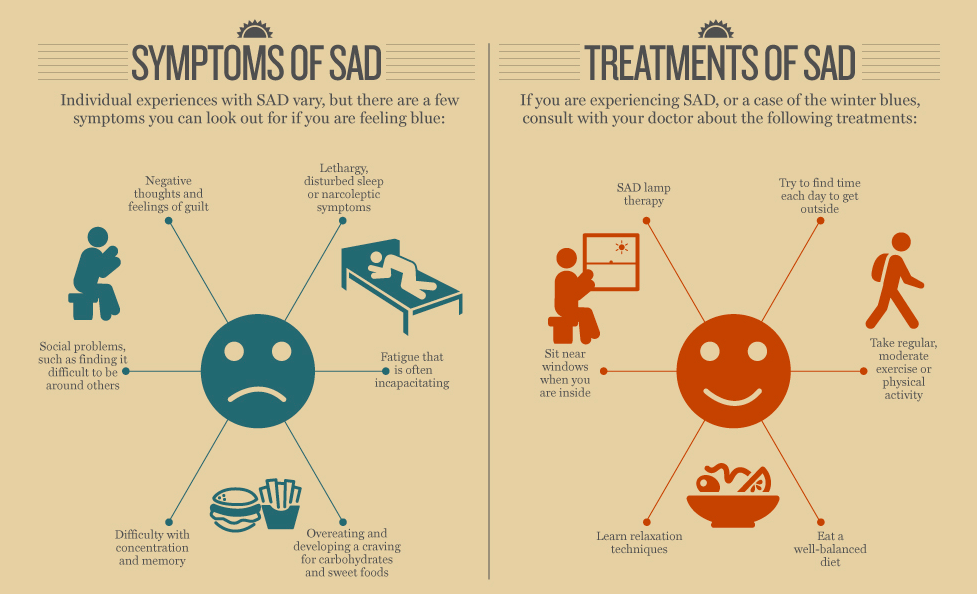
It is that time of the year again, it’s cold, the days are shorter, is mostly grey and dark outside: it is winter.
While for some it can be a season of snowboarding and skiing bliss and hot chocolate and hot toddies, for others it might be more difficult to find enjoyment in those gloomy winter days.
It happens to all of us to feel down some days, but if the feeling persists for several days and nothing can motivate you to get out of bed in the morning, you might be suffering from SAD or seasonal affective disorder.

What is SAD and how do I know if I have it?
According to the NHS definition, SAD is a type of depression that is related to the change in seasons: it begins and ends at the same time during the year and the majority of people will start to manifest the symptoms in autumn and continue suffering from them throughout winter. However there are also people who get the symptoms in the spring and continue having it throughout the summer, it is less common, but it is possible nevertheless.
If you normally do not suffer from any mental health issue, but experience depression – like symptoms in the fall only for them to go away in the spring, you might be suffering from this condition, and you should not brush these feelings away and should take them seriously. As with other type of depression, signs and symptoms can get worse if not treated and lead to having suicidal thoughts and wish to self-harm, social withdrawal and substance and alcohol abuse.

Winter – onset SAD symptoms may include the following: irritability, tiredness and / or low energy, problems getting along with other people, hypersensitivity to rejection, oversleeping, appetite changes and weight gain.
Summer – onset SAD symptoms may include the following: depression, disrupt sleep or even insomnia, weight loss or weight gain, poor appetite, agitation and/or anxiety.
As usual in these type of situations, a medical professional is the only person that can properly diagnose you, and if you feel you have one or more of these symptoms, talk to your GP.

Causes and risk factors
As per its definition, SAD is triggered by the change in seasons, however, pinpointing a specific cause remains elusive. In winter, a reduction in sunlight can disrupt several mechanisms in our body such as our circadian rhythm (our biological clock) and can cause a drop in our serotonin levels. The circadian rhythm is a roughly 24 hour cycle in our physiological processes (it extends to other living beings including plants, animals); this rhythm is affected by sunlight and temperature; the reduction of sunlight and the decreased temperature which occurs in winter can therefore disrupt our circadian rhythm and cause depression. Serotonin is a neurotransmitter which regulates our mood, and it is affected by sunlight as well, which means that those darker winter days cause a drop in our levels of serotonin, leaving us feeling moody and irritable.
Studies reveal that there are a few risk factors which render you more vulnerable to this conditions and they may include the following: being a female and a young adult, as well as, living farther away from the Equator, having a family history of SAD or suffering from other mental health issues such as being clinically depressed or bipolar.

What are the treatments available?
A doctor will advise you on a specific treatment for your case, based on severity of symptoms and your general state of health. Having said that, treatments available to cure SAD include photo-therapy, psychotherapy, medications, or a combination of the above.
What you can do at home and general tips
Let there be light.
Since SAD is linked to the decrease in sunlight, it might be beneficial to sit in front of a light box for a couple of hours every day, but, whenever possible, get outside in the natural sunlight, especially at midday when the sun shines brighter. Make your home as bright as possible, open the blinds and sit near a window.
Keep warm.
The recommended home temperature for healthy living is between 18 and 21 degrees Celsius. Drink plenty hot beverages such as herbal teas and infusions.
Eat healthily
A healthy and balanced nutrition is key to help you feel happy and energized.
Spend time with friends and family
Don’t be a hermit and go see friends and family or invite them to come around. It is so important not to isolate yourself even if your first instinct is to curl up on the couch never to be seen again until the spring.
Get movin’!
Join a gym, play a YouTube yoga or exercise video in your living room or go for a walk. 30 minutes of exercise every day can go a long way in improving your mood.
Play some cheerful music, louder.
I am sure your neighbour will bear with you if you play some good vibes tunes a bit louder for a few minutes not earlier than 8.30 am and not later than 10pm.
Take up a new hobby.
Dedicating time to doing something you truly love will certainly improve your mood.
Talk it out.
Join a support group where you can express your feelings in a safe and compassionate environment, keep a journal or talk with a friend. The most important thing is not to keep these thoughts and feelings to yourself. You are not alone and your feelings matter; reach out, you will be overwhelmed by the support you can get.

